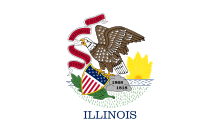1st Illinois Cavalry
| 1st Regiment Illinois Volunteer Cavalry | |
|---|---|

Illinois flag
|
|
| Active | July 3, 1861 to December 27, 1862 |
| Country | United States |
| Allegiance | Union |
| Branch | Cavalry |
The 1st Regiment Illinois Volunteer Cavalry was a cavalry regiment that served in the Union Army during the American Civil War and Spanish–American War.
Companies "A" to "G" of the 1st Illinois Cavalry were mustered into service at Alton, Illinois, on July 3, 1861. Among their initial officers was future Washington philanthropist David P. Jenkins, who served as the regiment's first major. Companies "I," "H" and "K" were mustered at Alton at later dates and never served with the main body of the regiment. The original companies served as guards for supply trains and depots until mustered out on July 14, 1862. The remaining companies served independently. The last company was mustered out on December 27, 1862.
Company H of the regiment was named "Noleman's Cavalry" after its captain, Robert D. Noleman. This company was organized at Centralia, Illinois, and mustered into service of the United States on June 14, 1861 for a period of one year. The group was first rendezvoused at Cairo, Illinois, but soon were transferred to Bird's Point, Missouri. They fought in the Battle of Belmont on November 7, 1861, and thereafter scouted through southeastern Missouri and western Kentucky during the winter of 1861–62.
On March 2, 1862, the group, joined by then-Colonel James D. Morgan, led the pursuit of Confederate Brigadier General M. Jeff Thompson in southeastern Missouri. They were unsuccessful in capturing Thompson but did capture artillery. Col. Morgan praised the group's perseverance and Gen. Thompson later recalled, "The cavalry are a perfect set of daredevils, all officers wearing feathers on their hats." From February to April 1862 the company joined Brigadier General John Pope in the Union effort to take New Madrid, or Kentucky Bend, on the Mississippi River. Their engagements included the Battle of Island Number Ten and the Confederate surrender after that battle at Tiptonville, Tennessee.
...
Wikipedia
